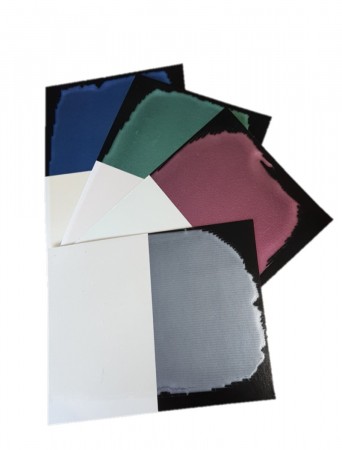Interference Metallic Paint
Availability:
- Also referred to as Iridescent Paints.
- Usually applied over black to create a very unique metallic colour with depth.
- When applied over white the colour effect is very weak.
- Highly durable for interior and exterior applications.
Interference Metallic Paints
Appearance
When applied over white the colour effect is very weak and only visible at certain angles. The metallic colour is strongest with just a single coat over black so these paints are usually applied over black paint. You can also apply the paint over light grey for a light metallic colour effect and over dark grey for a darker metallic colour effect (the darker the background the stronger the colour will be). Adding a second coat reduces the colour intensity. You can experiment by applying it over other colours to achieve more unique effects.
In the picture of the garden bench, we painted a single coat of Interference Metallic Green directly over black paint which results in a very strong metallic green colour. Painting over grey or adding a second coat of the Interference Metallic Green would lighten the green colour.
Green and Red give some iridescence (colour shift) when applied over white and at certain angles the red can appear green and vice versa. The effect over black and over white is clearly visible in the picture.
Watch this short video that explains and demonstrates these paints
Click here to see a 1 minute video showing Blue Interference Metallic Paint effect on a wooden bowl.
Technical explanation
Neither the paint nor the pigments in the paint actually have any colour, but pigments in the paint cause refraction and reflection of light within the paint yielding a colour appearance. When painted over black, all light that has not been sufficiently refracted or reflected is absorbed by the black background and only one colour of light is reflected to the observer. As no other colours of light are reflected, the colour effect is strong.
Tips
More coats of paint over the black or grey under-colour will reduce the metallic colour strength. Paint carefully so that you only require a single coat (or maximum two). If you later decide you want a lighter colour then just paint a second coat of Interference Metallic Paint and the colour will lighten significantly.
Application
Prepare and prime surfaces as per normal acrylic paint.
Paint these paints with brush, roller, airless spray or good air-spray equipment.as you would paint with other metallic paints.
- Paint with new, good quality brushes and rollers. Use a brush as little as possible; it is much easier to get a uniform finish using a roller.
- Avoid painting in conditions in which paint will dry very fast. Don't paint in direct sunlight, don't paint hot surfaces and apply a primer or undercoat to absorbent surfaces.
- Always keep a wet edge. To do this you must start in one corner (or edge) and paint without stopping until you reach the other corner of the wall (or other edge of the object).
- If painting a wall, move the roller only up and down (not left to right or diagonally) and always finish a roller or brush section with a continuous downward motion from top to bottom. Then start the next section with an overlap and do the same. If painting a horizontal item the same applies but final roller or brush movement should always be in the same direction.
- For walls, have a second person do the cutting-in along the ceiling and floor. They must stay just ahead of the painter with the roller who must roll over as much of the cut-in area as possible soon after it has been applied. Only about 20mm of brush cut-in area should not be rolled over.
- Rolling or brushing over paint that has already started to dry will mess up the pigment alignment so don't do this. If a section is not painted well it has to receive a second coat once the first coat is fully dry.
The above are the same guidelines as for painting with our Metallic Paints. There is an attachment on this page and in the Technical page of the website called "How to paint with Metallic Paints".
Unit Size |
|
| Unit Size | |
Package |
|
| Unit Size |
110ml
1 Litre
5 Litre
350ml
|
Colour |
|
| Colour |
Blue
Red
Green
Silver
|












